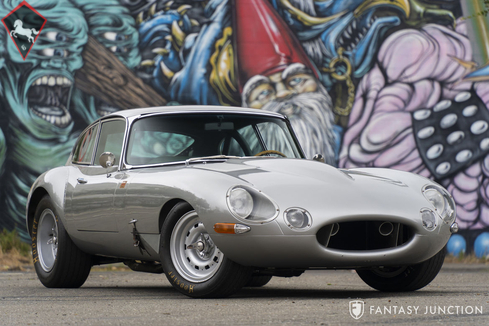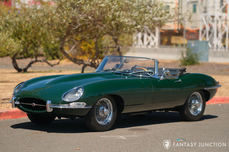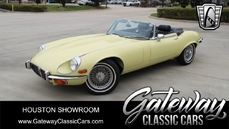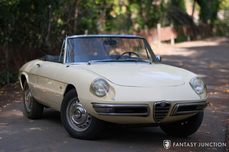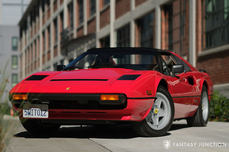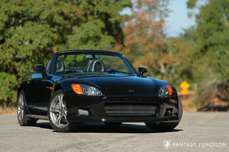Jaguar E-type 4.7L straight 6-cylinder 1963
Allmän beskrivning :
1963 Jaguar XKE Eagle Lightweight
s/n 888326 engine no. 8L99151H
Silver with Green Leather Interior
When Jaguar unveiled the XKE at the 1961 Geneva Motor Show, everything changed in the world of sports cars. Breathtaking design, unrivaled performance, and racing lineage made the XKE an immediate sensation. The beautiful lines and attractive pricing also made for top sales. But on the racetrack, the XKE proved out even more spectacularly with top performance recorded all over the world. In the same tradition that Jaguar built the original lightweight race cars, Eagle, the recognized experts in period correct XKE craftsmanship and performance enhancements, together with the commissioning owner, spared no expense creating this superb example of Jaguars’ legendary XKE Lightweight Coupe.
Built to impeccable standards by top fabrication specialists, following closely to factory specifications, using authentic parts, while enhancing performance and safety for contemporary competition use, this beautifully constructed Eagle Lightweight was hand-crafted with a host of professional contributing suppliers and performance experts, and completed in 2004. Beginning with a sound road car, this Series 1 coupe was completely disassembled and reconfigured to full Lightweight standards including extensive modifications to the engine, body, suspension, electronic systems, cooling system, brakes, and interior.
Beginning with the body, the structural steel core was retained while a set of custom RS hand-formed alloy body panels (alloy hood, doors, rear arches, and trunk lid) were fitted to the steel structure. A set of lightweight peg-drive Dunlop-type magnesium wheels were fitted, and the engine was comprehensively built by Rob Beere, updated to 4.7 Liter specifications. Engine improvements included big valve cylinder head with Sport cams, Sport lightened and balanced engine components, gas flowed head with matched ports, a gated anti-surge pump and big-bore tubular exhaust manifolds. The engine was mounted using specially fabricated Sport mounts, a harmonic crankshaft damper, electronic ignition with performance plug leads, and a modern performance electric fuel pump. Cooling was improved using a modern cooling fan, lightweight alloy radiator, brass water tank, and Kevlar reinforced cooling hoses. The 4.7 Liter engine was dyno-tuned returning 307hp at the rear wheels with more than 300 ft/pounds of torque from 3,200 to 5,200 rpm. An all synchro 5-speed Getrag gearbox was installed along with a 3.07:1 rear end. Brakes and suspension were upgraded as well with a high-powered stainless-steel shielded brake booster, AP front and rear alloy brake calipers with 315mm cross drilled ventilated rotors, and adjustable brake bias. GT torsion bars and springs, GT sway bars and bushings, polyurethane radius arm and arb bushings, Sport radius arm conversion, and billet aluminum steering rack mounts. Additional features included Spax adjustable shocks, high output charging system with 75-amp alternator, a lightweight geared starter motor, and halogen headlights. The total cost of the build and performance improvements exceeded $100,000.00.
Upon completion, the car was brought to California, titled, and registered as a 1963 Jaguar. The owner enjoyed the car for a few years before it was offered by Fantasy Junction and sold to the current consigning owner, at that time showing approximately 4,100 miles. An avid vintage performance car enthusiast, the current northern California owner engaged professional Jaguar performance specialists to service and upgrade the car as needed including regular fluids and service. In addition to general services including oil and filter changes, fluid exchanges, brake fluid flush, and seal replacement, a new electronic ignition kit was installed, the SU carburetors were tuned, ammeter removed and repaired, the water pump was rebuilt, various gaskets replaced, cooling system serviced, and various electrical wiring improved. The odometer currently indicates 4,533 miles.
Today the car presents as a spectacular example combining authentic aspects of the original Lightweight themes with impressive contemporary upgrades and excellent finishes throughout. The paint was done to a very high standard, with excellent gloss and consistent coverage, now showing just minor evidence of enjoyable use. Panel fit and gaps are excellent in all aspects of body construction including the muscular alloy rear fenders, smooth alloy nose, and alloy doors. With the front and rear bumpers removed, the body design is even more elegant and purposeful as a competition statement. The lighting, lenses, and windshield are in excellent condition including the leather bonnet latches, one of many handsome vintage touches. The magnesium wheels and Hoosier tires (rear set being wider than the front) create the perfect stance for this hunkered down XKE. The exposed rivet construction, outside alloy filler cap, and smoothed front/rear finishes all contribute to the competition presence of this Eagle Lightweight.
The interior of the car is as carefully thought out and as nicely detailed as the exterior. Opening the lightweight aluminum doors, the competition inspired interior is comfortable, not sparse, conveying the perfect balance of racing and road-going excellence. The seats are wrapped in supple green leather accompanied by 5-point seat harnesses, a leather wrapped central tunnel, black low-pile carpeting, and a stock XKE dashboard trimmed with green and black accents completes the interior finishes. Modest use is evident in the interior mostly to the driver’s side seat bolster which shows some wear from entry and exit. The wood steering wheel is slightly larger in diameter to allow improved rigidity under more spirited driving. The 5-speed Getrag gearbox is topped with an alloy shift knob and traditionally fitted with a matching green leather boot. A roll bar is installed, green headliner affixed to the inner roof panel and rear hatch, a modern fire system is in place, and a matching Dunlop type spare tire is located under the rear hatch panel. A custom-fabricated alloy fuel tank is in place, flanking the spare tire. The interior exhibits a nice blend of vintage competition Jaguars, with just enough comfort to enjoy driving without the harshness of typical competition cars.
Lifting the lightweight aluminum hood, the engine and engine bay reveals the 4.7 Liter engine with details prepared in homage to the original. Time and modest use have created a unified patina consistent with competition cars including heat toned header exhaust and buff aluminum finishes. Here too upgraded features have been thoughtfully installed for reliable use. Conceived and built with combined road and race use in mind, the engine systems are all easily accessed and modern upgrades including electronic ignition, electric fuel pump, modern alternator, and cooling enhancements (alloy radiator and electric fan) have proven to be appropriately specified. Further features include triple SU carburetors, traditional Lucas Engineering branded features, upgraded stainless steel braided fuel hoses, and an Optima battery. The underside of the car is very clean, nicely sorted, and appropriately finished reflective of the miles and use reported since the build was completed.
The car starts and drives very well. The 4.7 Liter engine is very strong with very quick throttle response and yet still usable for general driving, tours, or light duty track days. The 5-speed gearbox is a full synchro Getrag unit which operates smoothly. The brakes and steering are very well dialed in and the 3.07:1 rear end is suitable for highway use. In all, the driving experience is both invigorating and delightful, feeling very much like a competition car, in looks and heritage, but delivering a satisfying road manner that a capable driver can enjoy with confidence. The car is accompanied by numerous copies of build documentation, Eagle specifications sheets, dyno sheet, magazine articles, a series of photographs showing the build including body work and engine build, a car cover, and a set of tools in a tool roll.
For anyone seeking an exciting competition inspired car displaying exciting vintage presence, this Jaguar XKE Eagle Lightweight Coupe presents a unique design coupled with wonderful driving manners and superb performance that is sure to please any Jaguar performance enthusiast.
https://fantasyjunction.com/inventory/1963-jaguar-xke-eagle-lightweight-4-7/overview
1963 Jaguar E-type 4.7L straight 6-cylinder is listed såld on ClassicDigest in Emeryville by Fantasy Junction for $295000.
Fakta i bilen
Karosstyp : Personbil Märke : Jaguar Modell : E-type Modellversion : 4.7L straight 6-cylinder Motorvolym : 4.7 Årsmodell : 1963 Läge : Emeryville Fordon Registrering : Normal
Såld
Information om säljaren
Såld
People who viewed this Jaguar E-type also viewed similar Jaguar listed at ClassicDigest
Other cars listed for sale by this dealer
om Jaguar
Åh, historien om Jaguar, från dess tidiga dagar som SS Cars Ltd. till sin höjdpunkt med D-typen och gatubilsevolutionen i form av den ikoniska E-typen. Det finns något alldeles brittiskt över denna berättelse, och jag ska berätta den som en brittisk journalist skulle göra.
I början:
Vår resa in i Jaguar-världen börjar på 1930-talet, när ett företag som kallades SS Cars Ltd. dök upp. Trots den olyckliga sammanträffandet av deras initialer med de stigande politiska spänningarna i Europa började de producera stilfulla och prestandainriktade bilar. SS 100, som introducerades 1936, var en symbol för elegans och hastighet och lade grunden för vad som skulle bli Jaguar.
Jaguars födelse:
När skuggan av andra världskriget närmade sig beslutade SS Cars Ltd. klokt att distansera sig från SS-initialerna. Så 1945 blev de officiellt Jaguar Cars Ltd., ett namn som snart skulle bli synonymt med brittisk lyx och prestanda.
XK-serien:
Jaguars efterkrigstid gav oss XK 120, en verklig sensation 1948. Med sin strömlinjeformade design och en kraftfull 3,4-liters raksexmoters blev den världens snabbaste seriebil. XK 120 var ritningen för det som komma skulle - Jaguar som förenade stil med hastighet på ett unikt brittiskt sätt.
D-typens dominans:
Sedan kom D-typen, en sann racinglegend. Introducerad 1954, vann den Le Mans tre gånger på 1950-talet och visade Jaguars tekniska skicklighet. Med sin innovativa monokokkonstruktion och den ikoniska fenan bak var D-typen höjdpunkten av Jaguars framgång inom motorsport.
E-typens framträdande:
Men den verkliga vändpunkten kom 1961 med introduktionen av E-typen, ofta beskriven av Enzo Ferrari som "den vackraste bilen som någonsin byggts". Dess långa motorhuv, böljande kaross och en 3,8-liters motor som levererade upphetsande prestanda gjorde den till en omedelbar klassiker. E-typen var inte bara en bil; den var ett konstverk på hjul och kunde nå 150 mph på vägen.
Gata och racingsuccé:
E-typens skönhet matchades av dess förmåga på racerbanan. De lätta E-typarna var särskilt framgångsrika i olika racingevenemang och cementerade Jaguars rykte som en kraft att räkna med inom motorsport.
Raffinemangets ålder:
När vi fördjupar oss i Jaguar-historien finner vi att 1950-talet och 1960-talet var en tid av raffinering och expansion. Tillsammans med den magnifika D-typen och den ikoniska E-typens framträdande introducerade Jaguar modeller som ytterligare befäste sitt rykte för lyx och prestanda.
MK2:
I slutet av 1950-talet presenterade Jaguar MK2, en sportig sedan som kombinerade elegans med kraft. Denna eleganta fyradörrars salong var en favorit bland bankrånare och polisen, tack vare dess exceptionella hastighet och hantering. MK2 var en symbol för Jaguars förmåga att förena sofistikering med prestanda och hade också en framgångsrik racingkarriär.
XJ6:
Hoppa fram till 1968 och Jaguar lanserade en bil som skulle definiera lyxbilar i decennier framöver - XJ6. Det var ett mästerverk i teknik och design med en jämn raksexmoters, oberoende bakre fjädring och en rymlig, vackert inredd interiör. XJ6 var en symbol för brittisk elegans och erbjöd en så smidig åktur att det kändes som om den gled över vägen. Den blev flaggskeppsmodellen för Jaguar och satte standarden för lyxbilar och visade en nivå av raffinering som imponerade på konkurrenterna.
Blandningen av klassiskt och modernt:
Medan MK2 och XJ6 representerade utvecklingen av Jaguars sedanmodeller, bibehöll de märkets engagemang för prestanda och lyx. Dessa bilar hörde inte bara hemma på racerbanan; de trivdes lika bra på de stora boulevarderna som på en avslappnad körning genom den engelska landsbygden.
Utmaningarna av förändring:
Men när 1970-talet närmade sig, ställdes Jaguar, liksom många brittiska biltillverkare, inför ekonomiska utmaningar och ägarförändringar. British Leyland-eran förde både möjligheter och svårigheter med sig när varumärket navigerade genom olika sammanslagningar och övergångar.
Ändå fortsätter arvet från MK2 och XJ6, tillsammans med D-typen och E-typen, att definiera Jaguar som en tillverkare som förenar tidlös elegans med en anda av prestanda. Dessa klassiska modeller, vare sig de körs på slingrande vägar eller står som samlarföremål, tjänar som ett vittnesbörd om Jaguars långvariga närvaro inom den automobila exklens värld.
Jaguar-historien, från dess tidiga dagar som SS Cars Ltd. till skapandet av ikoner som E-typen, MK2 och XJ6, är en resa som speglar essensen av brittisk bilkultur - en blandning av lyx, kraft och stil som fortsätter att fängsla entusiaster och samlare över hela världen.
